 |
| The Independent Traveler's Newsletter PAGE FOUR |
 |
| The Independent Traveler's Newsletter PAGE FOUR |
|
Happily
'Lost' in the French countryside continued . . .  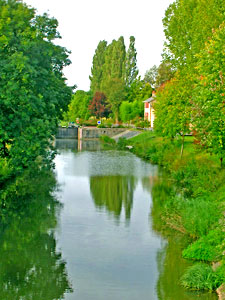 If you
are traveling west of Paris into Normandy, the département of the Orne has a precious little village
by the name of Saint-Cénerei-le-Gérei, a
very deserving member of Les Plus
Beaux Villages de France. It
lies on the banks of the River Sarthe, one of our favorite rivers in
France, and is peaceful and very charming. Artists have always
been
drawn to the beauty of this village and its wooded setting on a loop of
the Sarthe. There is an annual festival in the town celebrating the
artists who have come here to work or live. A fine rental
property in this region is Château de
Courtomer, which is let by the week or for shorter stays. If you
are traveling west of Paris into Normandy, the département of the Orne has a precious little village
by the name of Saint-Cénerei-le-Gérei, a
very deserving member of Les Plus
Beaux Villages de France. It
lies on the banks of the River Sarthe, one of our favorite rivers in
France, and is peaceful and very charming. Artists have always
been
drawn to the beauty of this village and its wooded setting on a loop of
the Sarthe. There is an annual festival in the town celebrating the
artists who have come here to work or live. A fine rental
property in this region is Château de
Courtomer, which is let by the week or for shorter stays.Speaking of the River Sarthe, it is the perfect river to follow on a visit to France. The Sarthe flows through villages such as Solesmes ~ a village built around the grand Abbey de Solesmes famous for the Benedictine monks' Gregorian chants, then through Châteauneuf-sur-Sarthe, Morannes and finally Briollay, where its right branch becomes the Loir River. It empties into a branch of the Mayenne north of the Loire city of Angers. If you begin in Angers and travel north along the river, you will come upon Parcé-sur-Sarthe [in photo] after Solesmes, which is about as peaceful a village as you could find anywhere. As the river snakes around from the north, you will pass Noyen-sur-Sarthe where very soon you will arrive at Château de Vaulogé, a wonderful bed and breakfast surrounded by a moat where you can enjoy a true château experience. Also in the département of the Sarthe but not on the river are Château de la Barre, now in the same family for 596 years, is an exceptionally elegant bed and breakfast also offering two charming apartments, and Château du Grand-Lucé is a spectacular large château to rent for gatherings of family and friends. The Sarthe continues to flow from the northwest where it cuts through the city of Le Mans. At Montbizot, about 20 kilometers north of Le Mans, it is again tiny streams that formed the river. Its source is in the Orne of Normandy near the village of Moulins-la-Marche, barely discernible on a map. The entire Sarthe region of France is so beautiful, very unique and a place you will remember for a very long time to come.
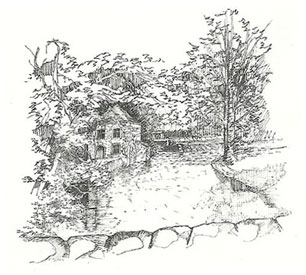 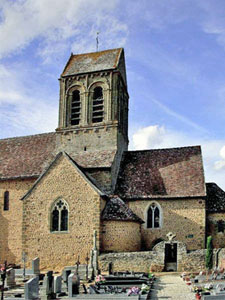 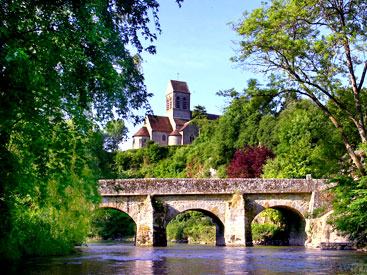 SAINT-CÉNERI-LE-GÉREI
 Driving farther west into Normandy, we go to the northernmost tip of the Manche département to the seaside village of Barfleur which was the primary port of embarkation for England in the Middle Ages. In 1066, William the Conqueror left from Barfleur before the Battle of Hastings. Note the English-style church. There are still natural mussel banks on its coast providing the moules de Barfleur ~ don't visit without enjoying them in one of the many wonderful restaurants that line the harbor. On the 23rd of April, Barfleur became a new departure point of the Way of St James to Santiago de Compostela (Saint Jacques de Compostelle) via Le Mont St-Michel. A bronze medallion has been sealed into a cobblestone paver at the Square Guillaume Le Conquérant (William the Conqueror), and a stamp has been created to testify to the credential of a pilgrim (the pilgrim's passport) departing from Barfleur. This stamp can be obtained at the tourist office near the medallion. Two excellent places to stay at the northern tip of the Manche are Château de Servigny, a château rented by the week and the historic location of the only signing of a peace treaty during World War II: it was June 26, 1944 at 4PM and marked the Surrender of Cherbourg when the Treaty of Servigny was signed by American General Joseph Lawton Collins and German General Karl Wilhelm Von Schlieben in the drawing room of this Château. Nearby is Le Pavillon de Château de Tocqueville, formerly the country home of Alexis de Tocqueville, the highly-acclaimed political thinker, historian and 19th-century author, perhaps best known for his extraordinary work, Democracy in America (1835) following his travels in the United States. Lovely guest accommodations make this a wonderful base for exploring the Cotentin Peninsula and the historic sites of Normandy. 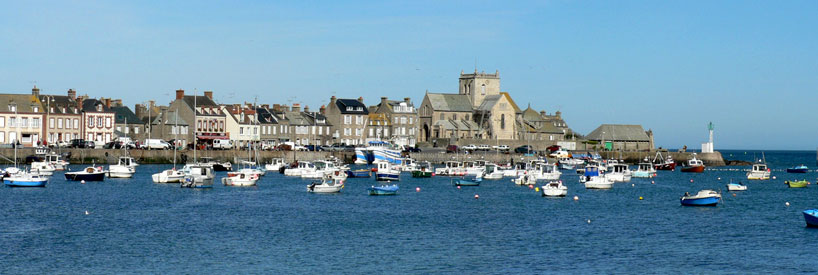 BARFLEUR 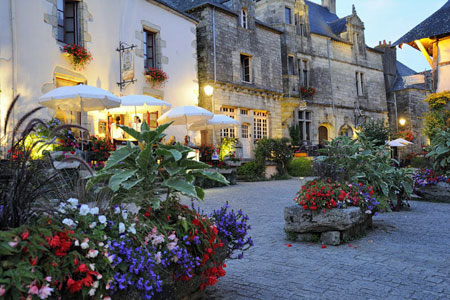  Searching for more Plus Beaux
Villages, we head southeast to Brittany's Morbihan département to visit Rochefort-en-Terre,
one of those villages you simply cannot visit only once. Its
architectural mix of half-timbered houses, Gothic monuments,
Renaissance hotels and 19th century buildings are all linked together
by the same golden stone creating an exceptionally pretty
village. One of the most notable and enjoyable features of the
village are the shop and restaurant signs ~ each a work of art in
itself. Searching for more Plus Beaux
Villages, we head southeast to Brittany's Morbihan département to visit Rochefort-en-Terre,
one of those villages you simply cannot visit only once. Its
architectural mix of half-timbered houses, Gothic monuments,
Renaissance hotels and 19th century buildings are all linked together
by the same golden stone creating an exceptionally pretty
village. One of the most notable and enjoyable features of the
village are the shop and restaurant signs ~ each a work of art in
itself. 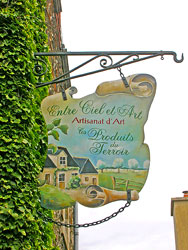 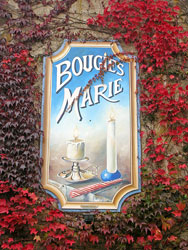 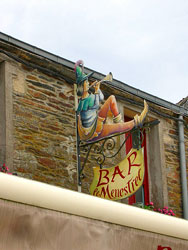 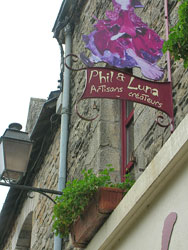  Still in Brittany the next special village is in the Côtes d'Armor département ~ Moncontour. Its ramparts and towers tell of a past filled with turmoil and battles. In Medieval times its hilltop position provided defense for the Lords of Penthièvre and was a magnet for conflict ~ first in the 14th century Breton War of Succession, then the 15th century conflict between the Breton duchy and the French state, and the 16th century Wars of Religion. It survived as a mercantile center in the more peaceful times that followed. Today, it is a pleasant, lively town with pretty views around every corner. 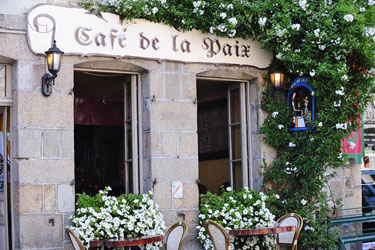 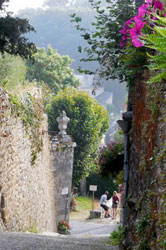 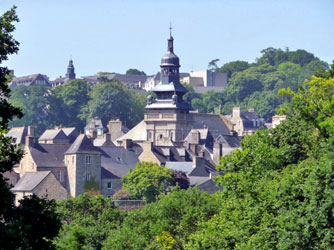 MONCONTOUR  Finally, we finish in Brittany's Finistère département, about as far as we can be from our starting point in Provence. It is here that you find the village of Locronan, where, legend has it, an Irishman named Ronan settled here in the Dark Ages. He spread Christianity in western Brittany, settled in Locronan and became a revered resident after having saved a young girl's life. Each year the townsfolk complete their tromenie (Breton for sacred walk): twelve kilometers of prayer. This year it will be held on July 9th. In Medieval times, with its proximity to the sea, sailmaking was the village's primary industry, and the town prospered. Visitors today ascend the nearby summit to see an unobstructed view of the Bay of Douarnenez. Most interesting is the fact that Locronan is not only a member of Les Plus Beaux Villages de France, but it is also a Breton Petite Cité de Caractère ~ whenever judges come to town for any reason, they fall in love with Locronan! North of Locronan in the direction of the port of Brest is Domaine de Moulin Mer, an inviting bed and breakfast in Logonna-Daoulas at the northern edge of the Parc Naturel Régional d'Armorique. The coastline of a protected bay is beautiful, and the Domaine offers an environmentally-friendly accommodation for its guests. 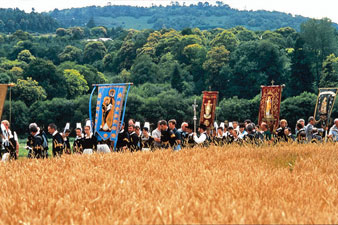 LOCRONAN
THE TROMENIE
We hope you have enjoyed this
virtual visit to some of France's most unique little villages. In
the event that any appear on your future itinerary, we have provided
suggestions for some equally unique places to stay throughout the text
that you might want to consider. [Editor's note:
Most of the recommended accommodations are members of our sister site, au Château,
and have been either personally visited by us or were places we stayed
and enjoyed.]
ART EXPO - LES CARRIÈRES, LES BAUX Bosch - Brueghel - Arcimboldo March 4, 2017 to January 7, 2018 Produced by Culturespaces and created by the Italian team of Gianfranco Iannuzzi, Renato Gatto, and Massimiliano Siccardi, with the musical collaboration of Luca Longobardi, this new exhibition at the limestone caves of Les Carrières, Les Baux, situated to the north of Marseille, invite you this year to explore the unbridled imagination of the animated paintings of Bosch, Brueghel and Arcimboldo. In a former quarry, it is an art-based multimedia show, projecting images of famous paintings set to music. 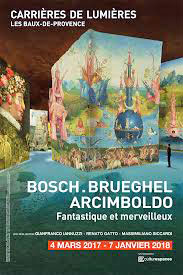 From Hieronymus Bosch’s most
emblematic triptychs, such as The
Garden of Earthly Delights, The
Temptation of Saint Anthony, and The Hay Wagon, to Giuseppe
Arcimboldo’s remarkable compositions of flowers and fruit, and the
village festivities depicted by the Bruegel dynasty, the Carrières de Lumières
embraces the fascinating worlds of the great masters who represented
these animated scenes of life and the duality of a world shifting
between good and evil. Their work shares the same excellent structure
and incredible inventiveness. Bosch’s hallucinatory imagination
and Arcimboldo’s highly creative and improbable faces are complemented
by the joyous triviality of Bruegel’s works, whose many figures
are inspired by reality. From Hieronymus Bosch’s most
emblematic triptychs, such as The
Garden of Earthly Delights, The
Temptation of Saint Anthony, and The Hay Wagon, to Giuseppe
Arcimboldo’s remarkable compositions of flowers and fruit, and the
village festivities depicted by the Bruegel dynasty, the Carrières de Lumières
embraces the fascinating worlds of the great masters who represented
these animated scenes of life and the duality of a world shifting
between good and evil. Their work shares the same excellent structure
and incredible inventiveness. Bosch’s hallucinatory imagination
and Arcimboldo’s highly creative and improbable faces are complemented
by the joyous triviality of Bruegel’s works, whose many figures
are inspired by reality. In this new immersive exhibition, which lasts around thirty minutes and includes more than 2,000 digital images projected on a total surface area of 7,000 m2, the Carrières de Lumières will be filled with innumerable fantastical creatures and allegorical figures. These are depicted spontaneously, and some are frightening and others amusing and caught up in comic situations ~ all these characters are reflections of the viewers. Man’s vanities, spirituality, pleasures, temptations, and vices are all evident in the landscapes painted with an acute sense of detail by Bosch, Bruegel, and Arcimboldo. The show ends with Bosch’s wonderful Garden of Earthly Delights, inviting visitors to enter a phantasmagorical world. The exhibition's soundtrack oscillates between classical and contemporary music, playing, for example, the famous pieces Carmina Burana, by Carl Orff, The Four Seasons by Antonio Vivaldi, reinterpreted by Max Richter, the works of the Russian composer Modeste Petrovitch Mussorgsky, and music by the British rock group Led Zeppelin. Between two screenings of the show, there is a shorter six-minute interlude with a film that pays tribute to Georges Méliès, an ingenious filmmaker and inventor at the beginning of the twentieth century, where the audience can embark on a magical, fantastic journey: the Méliès workshop is the departure point, but one soon encounters astonishing creatures created by the inventor that live in the abysses and hells, as well as his famous moon. Blending emotion, rolls of old films, and wonderful visions, the show pays tribute to the child inside the man known as the ‘Cinemagician’. Previous exhibitions at the limestone caves, Les Carrières, in les Baux have featured a stunningly superb display of the paintings of Gustav Klimt and the Viennese Secessionists, including the very famous painting of Adele Bloch-Bauer entitled A Century of Gold and Colours. Last year's show was devoted to the works of Chagall, while others over the years have been devoted to French Impressionists, the art of Provence, and artists of the Italian Renaissance. The shows are staggering in their ability to sink one into the world of the artist’s works, in the quality of photography and reproduction, and the very positive linkage of works, tracing the development of artists. A useful note for visitors: the limestone caves are a wonderful place to visit in high summer, being very cool, to quite cold inside, so a cardigan or sweater is recommended. For more information you can visit the site www.carrieres-lumieres.com.  Anita Rieu-Sicart publishes a newsletter for expats in the Var département of Provence ~ The Var Village Voice ~ which is well worth subscribing to whether you live there or not. It is filled with important and interesting information about the region, France and issues expats face every day. Contact her at : anita@varvillagevoice.com or subscribe to the newsletter at: www.varvillagevoice.com
DISCLAIMER: You have received this newsletter because your email address is on our Opt-In mailing list, i.e., you have requested to receive FRANCE On Your Own ©. If you would like to discontinue receipt of this newsletter, please send an email to publisher@franceonyourown.com with "unsubscribe" on the Subject line. Unless indicated otherwise, photos, graphics, artwork and text in the FRANCE On Your Own © newsletter are all the property of Cold Spring Press and FRANCE On Your Own © and cannot be copied, duplicated or used in any manner by anyone without the express written permission of Cold Spring Press. FRANCE On Your Own © is published online by Cold Spring Press, P O Box 26098, San Diego, California 92196-0098. This publication is copyrighted and no portions of the text, artwork, graphics or photographs may be reproduced or distributed in any form or by any means or stored in a database or retrieval system without the written permission of the Publisher. For more information about FRANCE On Your Own ©, visit our web site at http://www.franceonyourown.com. Recommendations made in this newsletter are based upon the personal experiences of the Publishers or contributing writers solely to provide information to subscribers. Cold Spring Press and FRANCE On Your Own © make no endorsements nor are any guarantees or promises of satisfaction given or implied. Any and all information is correct to the best of our knowledge, and the Publishers accept no responsibility for errors and/or omissions. The responsibility lies entirely with the traveler to obtain current information regarding accommodations, availability, schedules, prices, reservations, or any other pertinent details. We do not guarantee the historical accuracy of the contents of articles in this newsletter. Historical accuracy is dependent upon one's sources of information -- and contradictions often exist among those sources. Links to other web sites or email addresses are provided for informational purposes only and do not imply any guarantees of service or endorsement of any organization or their business practices. FRANCE On Your Own © is electronically transmitted via email. To add your email address to our database for this FREE newsletter, send an email to info@franceonyourown.com, and please put Subscribe in the subject line. We do not share email addresses with any other organization. BACK ISSUES of the print version of FRANCE On Your Own © and Free online back issues are available on our web site at http://www.franceonyourown.com/Archives.htm. ©1997-2017
Cold Spring Press All Rights Reserved
|
|
 previous
page
previous
page |